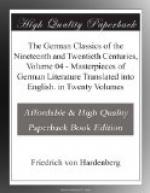Among so many connoisseurs of art, the Princess enjoyed in silence.
The ascent of the dome Gaspard recommended to defer to a dry and cloudless day, in order that they might behold the queen of the world, Rome, upon and from the proper throne; he therefore proposed, very zealously, the visiting of the Pantheon, because he was eager to let this follow immediately after the impression of Saint Peter’s church. They went thither. How simply and grandly the hall opens! Eight yellow columns sustain its brow, and majestically as the head of the Homeric Jupiter its temple arches itself. It is the Rotunda or Pantheon. “O the pigmies,” cried Albano, “who would fain give us new temples! Raise the old ones higher out of the rubbish, and then you have built enough!” [7] They stepped in. There rose round about them a holy, simple, free world-structure, with its heaven-arches soaring and striving upward, an Odeum of the tones of the Sphere-music, a world in the world! And overhead[8] the eye-socket of the light and of the sky gleamed down, and the distant rack of clouds seemed to touch the lofty arch over which it shot along! And round about them stood nothing but the temple-bearers, the columns! The temple of all gods endured and concealed the diminutive altars of the later ones.
Gaspard questioned Albano about his impressions. He said he preferred the larger church of Saint Peter. The knight approved, and said that youth, like nations, always more easily found and better appreciated the sublime than the beautiful, and that the spirit of the young man ripened from strong to beautiful, as the body of the same ripens from the beautiful into the strong; however, he himself preferred the Pantheon. “How could the moderns,” said the Counsellor of Arts, Fraischdoerfer, “build anything, except some little Bernini-like turrets?” “That is why,” said the offended Provincial Architect, Dian (who despised the Counsellor of Arts, because he never made a good figure except in the esthetic hall of judgment as critic, never in the exhibition-hall as painter), “we moderns are, without contradiction, stronger in criticism; though in practice we are, collectively and individually, blockheads.” Bouverot remarked that the Corinthian columns might be higher. The Counsellor of Arts said that after all he knew nothing more like this fine hemisphere than a much smaller one, which he had found in Herculaneum molded in ashes, of the bosom of a fair fugitive. The knight laughed, and Albano turned away in disgust and went to the Princess.
He asked her for her opinion about the two temples. “Sophocles here, Shakespeare there; but I comprehend and appreciate Sophocles more easily,” she replied, and looked with new eyes into his new countenance. For the supernatural illumination through the zenith of Heaven, not through a hazy horizon, transfigured, in her eyes, the beautiful and excited countenance of the youth; and she took for granted that the saintly




